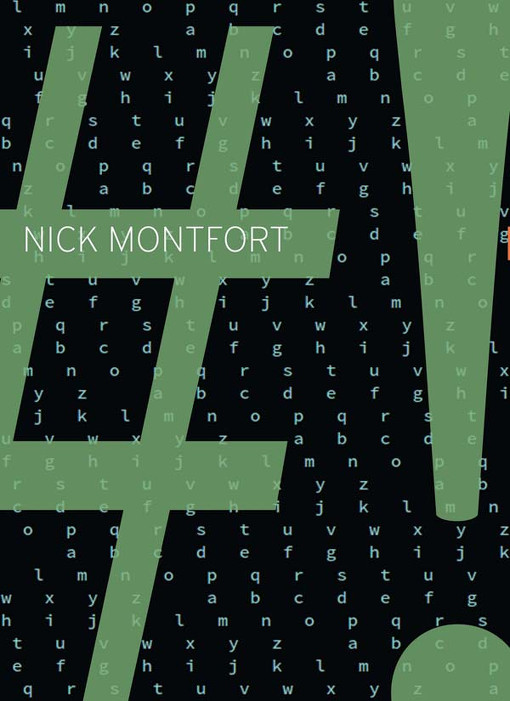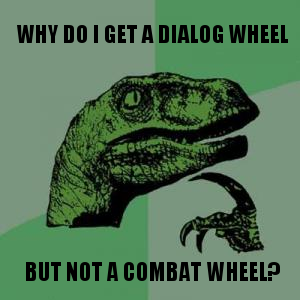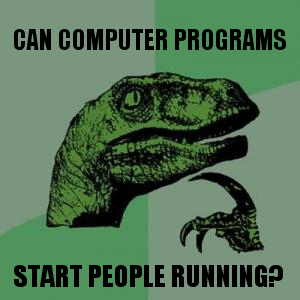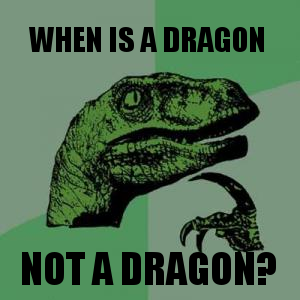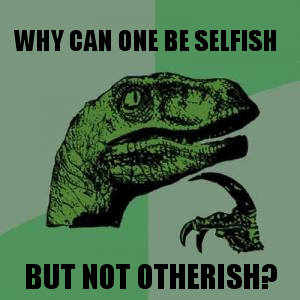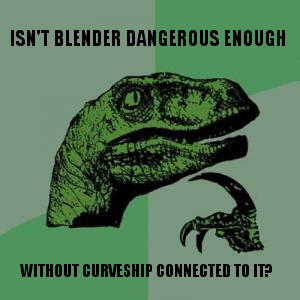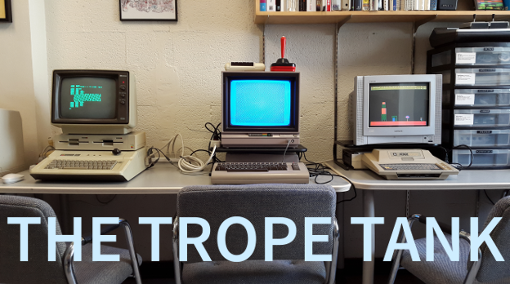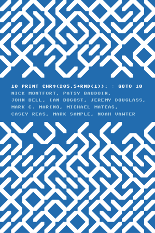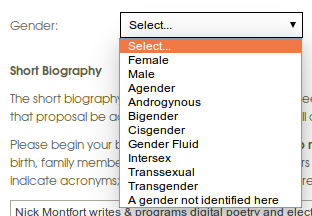Everything you need to know to print out and bind a copy of Left Cartridge, a zine documenting the Learning Games Initiative, is online.
Digital Media Studies via GIF
Crazy idea? Of course. And yet Zach Whalen has been doing it, quite successfully, on Tumblr. For instance, here’s his brand-aware version of Brion Gysin’s permutation poem:

And his speedrun of Lexia to Perplexia:

Not to mention the excellent staticy CRTs, captured from films and TV, not to mention the exquisite and worth-the-trip Zen for GIF.
A Companion Disk for 10 PRINT
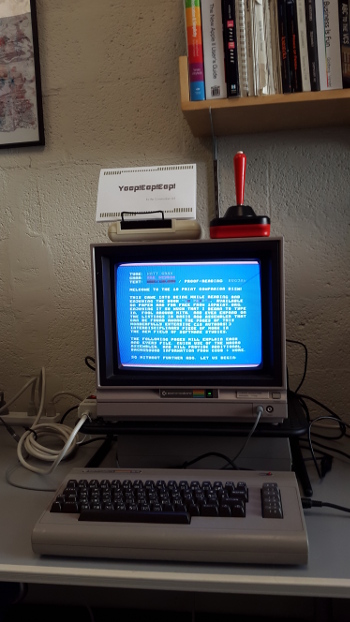 Martin Schemitsch (a.k.a. Martinland) has compiled and released a disk to accompany our book 10 PRINT CHR$(205.5+RND(1)); : GOTO 10, one that’s full of BASIC and assembly programs. These include the programs in the book and the later, more compact versions of our demo thread. The disk was just released at Commodore-Treffen Graz $14, and of course the disk image is available for download. It’s a nice companion to the 10 PRINT book and a Commodore 64 emulator, although, as you can see, it also works perfectly well on a vintage Commodore 64.
Martin Schemitsch (a.k.a. Martinland) has compiled and released a disk to accompany our book 10 PRINT CHR$(205.5+RND(1)); : GOTO 10, one that’s full of BASIC and assembly programs. These include the programs in the book and the later, more compact versions of our demo thread. The disk was just released at Commodore-Treffen Graz $14, and of course the disk image is available for download. It’s a nice companion to the 10 PRINT book and a Commodore 64 emulator, although, as you can see, it also works perfectly well on a vintage Commodore 64.
Two Kinds of Bots
Following up the excellent ELO conference, Mark Sample offers a post on “Closed Bots and Green Bots” which divides bots in a very compelling, interesting, and productive way.
#! is Published
My new book of programs/poems, #! (pronounced “Shebang”), has just been published by Counterpath.
Read all about it on the press’s page for #!.
The book consists of poetic programs and their outputs. The programs in the book are all free software, and in case you don’t want to type them in, the longer ones are all available in my “code” directory.
I hope you’ll get a copy at your local independent bookseller.
Computational Narrative and Games (Special Issue)
A special issue of IEEE Transactions on Computational Intelligence and AI in Games (TCIAIG) is now out — I mention it because I was one of the editors, and the issue deals with computational narrative and games.
Here’s the link to the computational narrative and games issue. It was edited by Ian Horswill, Nick Montfort and Michael Young. And here’s what is in it:
Guest Editorial
Horswill, I.D; Montfort, N; Young, R.M
p 92-96
Social Story Worlds With Comme il Faut
McCoy, J. ; Treanor, M. ; Samuel, B. ; Reed, A.A. ; Mateas, M. ; Wardrip-Fruin, N.
p 97-112
Versu—A Simulationist Storytelling System
Evans, R. ; Short, E.
p 113-130
A Computational Model of Narrative Generation for Surprise Arousal
Bae, B.-C. ; Young, R.M.
p 131-143
Automated Story Selection for Color Commentary in Sports
Lee, G. ; Bulitko, V. ; Ludvig, E.A.
p 144-155
Skald: Minstrel Reconstructed
Tearse, B. ; Mawhorter, P. ; Mateas, M. ; Wardrip-Fruin, N.
p 156-165
Designing User-Character Dialog in Interactive Narratives: An Exploratory Experiment
Endrass, B. ; Klimmt, C. ; Mehlmann, G. ; Andre, E. ; Roth, C.
p 166-173
Personalized Interactive Narratives via Sequential Recommendation of Plot Points
Yu, H. ; Riedl, M.O.
p 174-187
Lessons on Using Computationally Generated Influence for Shaping Narrative Experiences
Roberts, D.L. ; Isbell, C.L.
p 188-202
A Supervised Learning Framework for Modeling Director Agent Strategies in Educational Interactive Narrative
Lee, S.Y. ; Rowe, J.P. ; Mott, B.W. ; Lester, J.C.
p 203-214
Shall I Compare Thee to Another Story?—An Empirical Study of Analogy-Based Story Generation
Zhu, J. ; Ontanon, S.
p 216-227
Analysis of ReGEN as a Graph-Rewriting System for Quest Generation
Kybartas, B. ; Verbrugge, C.
p 228 – 241
Thoughts from INT7, Day One
(These pertain to Intelligent Narrative Technologies 7, and specifically today’s presentations. Perhaps, if you’re here, you will laugh. If you aren’t here, my regrets.)
Waves 3 Ways at @Party
codewiz and I (nom de nom) showed a wild demo at @party yesterday (June 14) at MIT.
It was “Waves 3 Ways (Topsy’s Revenge).” Indeed, there’s video.
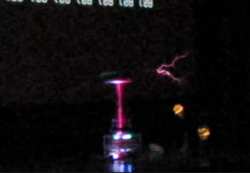 The concept is based on one-line C programs to generate music, the earliest of which were by viznut. I (nom de nom) wrote a C expression in this style to generate a waveform that could be output as sound but
The concept is based on one-line C programs to generate music, the earliest of which were by viznut. I (nom de nom) wrote a C expression in this style to generate a waveform that could be output as sound but
also consisted of all printable ASCII characters. The source is about 1kb, without much effort at compression. And the sound, in addition to driving speakers, can be (and was) connected to a Tesla coil.
To connect the oneTesla coil he built, codewiz modified the firmware and the control box to allow the audio output to be read by the potentiometer input. He also wrote dsptee.c to improve the way the text scrolls.
Topsy was the elephant electrocuted by Thomas Edison in 1903 to help prove that AC electricity (advocated by Tesla) was unsafe.
My main disappointment was that the projector, which I thought would be HD and thus the same as my display, showed only the left-hand side of the video. I should have checked it more thoroughly before we got started.
We were very pleased to get second place behind a nice oscilloscope demo.

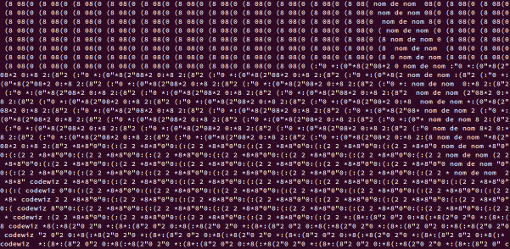
The final section of the demo is based on the bpNichol poem “Island,” part of his Apple IIe collection First Screening. This poem, in turn, refers to a concrete poem by Ian Hamilton Finlay. I’ve put a video/screencast of the end of the production online.
Trope Tank Annual Report 2013-2014
I direct a lab at MIT called The Trope Tank. This is a lab for research, teaching, and creative production, located in building 14 (where the Hayden Library is also housed), in room 14N-233. Its mission is to develop new poetic practices and new understandings of digital media by focusing on the material, formal, and historical aspects of computation and language.
The lab’s website has just been updated with some new information about our two major creative/research projects, Slant and Renderings. Earlier this academic year, a hardware and software catalog of Trope Tank resources was developed by Erik Stayton with contributions from Sylvia Tomayko-Peters.
As usual, the Trope Tanks hosts the monthly meetings of the local interactive fiction club, the People’s Republic of Interactive Fiction. Also, the Trope Tank’s series of digital writing presentations, Purple Blurb, continued this year; I was on leave in Fall 2013, but the series was back and hosted four excellent presentations in Spring 2014. See those sites for more information about PR-IF and Purple Blurb.
Here’s what we’ve been up to since our last annual report in May 2013:
New Works: Creative projects released.
- Nanowatt, single-loading (3.5 KB) demoscene production for the VIC-20. By Nick Montfort, Michael C. Martin, and Patsy Baudoin as Nom de Nom, McMartin, and Baud 1. Shown and awarded 2nd place on 30 November 2013 at Récursion, Montréal.
- World Clock, computer generated novel with source code by Nick Montfort. Published on the Web 30 November 2013, in print at the Harvard Book Store.
- Round, digital poem by Nick Montfort. Published on the Web 14 August 2013 by New Binary Press.
- Duels — Duets, digital poem. By Stephanie Strickland and Nick Montfort. Published on the Web 14 August 2013 by New Binary Press.
- The Deletionist, digital poetry system. By Nick Montfort, Amaranth Borsuk, and Jesper Juul. 2011–2013. Premiered at E-Poetry 2013 in London and published on the Web.
- Three Rails Live, an interactive video installation. By Rod Coover, Nick Montfort and Scott Rettberg. 2011–2013. Documentation published on the web in bleuOrange 7, 2013.
Trope Reports: We have issued two technical reports.
- TROPE-13-02 – Videogame Editions for Play and Study (Clara Fernández-Vara and Nick Montfort)
- TROPE-13-03 – No Code: Null Programs (Nick Montfort)
Exhibit & Museum Event:
- Second Fridays: How People Connect, Presentation of Commodore 64 BASIC programming, Piotr Marecki and Erik Stayton, and event at the MIT Museum, February 14, 2014
- Programs at an Exhibition, Nick Montfort & Páll Thayer, an exhibit at the Boston Cyberats Gallery, March 6-16, 2014
Presentations:
- Marecki, Piotr, “Sticker literature or augmented reality literature,” David Foster Wallace Conference, Department of English, Illinois State University, May 23, 2014
- Marecki, Piotr, “The Road to Assland and early Polish Text Adventure Games,” People’s Republic of Interactive Fiction, The Trope Tank, MIT, May 13, 2014
- Montfort, Nick, “Combinatory Media and Possibilities for Documentary,” OpenDoc Lab, MIT, May 8, 2014
- Marecki, Piotr, “Polish Literature in the Digital Age,” MIT Comparative Media Studies/Writing, May 7, 2014
- Marecki, Piotr, “Textual Caves: Expanding the Literary Writing Space,” Shapeshifters: Recycling and Literature, Department of Comparative Literature, Yale University, April 25-26 2014
- Montfort, Nick “Exploratory Programming,” first of four major topics for the online Critical Code Studies Working Group 2014, 23 February-23 March, 2014.
- Montfort, Nick, “Aesthetic Obfuscated Code,” Symposium on Obfusctation, New York University, 15 February 2014.
- Montfort, Nick, “Ten Cases of Computational Poetics,” UCLA, M/ELT, 17 January 2014.
- Montfort, Nick, “Computational Poetic Models,” University of Southern California, SCA Complex, 16 January 2014
- Marecki, Piotr, “Polish Literature in the Digital Age,” IAP talk, MIT, January 21, 2014.
- Montfort, Nick, “Computational Literary Models for Fun and Poetics,” Concordia University, Montréal, 10 January 2014.
- Montfort, Nick, “Scaling Up Literary Models with Curveship and Slant,” 8th Mexican International Colloquium on Computational Creativity, UNAM, Mexico City, 15 November 2013.
- Montfort, Nick, “Literary Models,” 8th Mexican International Colloquium on Computational Creativity, UAM Cuajimalpa, Mexico City, 14 November 2013.
- Montfort, Nick, “Electronic Literature and Other Forms of Popular Creative Computing.” Keynote address at Writing Literature, Reading Society, Municipal Public Library, Kraków, 29 October 2013.
- Montfort, Nick, “10 PRINT,” MIT CSAIL Programming Language & Software Engineering retreat, MIT Endicott House, 21 May 2013
- Montfort, Nick, “Hardware and Emulation to Access Creative Computing,” Preserving.exe Summit, Library of Congress, 20 May 2013
- Baudoin, Patsy and Nick Montfort, “10 PRINT,” Writing Across the Curriculum, MIT, 17 May 2013
Translations: Andrew Campana translated “The Two” by Nick Montfort into Japanese. Piotr Marecki translated Montfort’s “Lede,” “The Two,” and World Clock (via translation of the novel-generating program) into Polish, and, with Aleksandra Małecka, translated “Between Page and Screen” by Amaranth Borsuk and Brad Bouse into Polish. These will be placed online when revisions are complete.
Teaching:
- The Trope Tank hosted a visit by The Word Made Digital, 21W.764, during Spring 2014.
- “Exploratory Programming Workshop” by Nick Montfort, New York University, 14 February 2014.
- Commodore 64 BASIC Workshop by Nick Montfort, offered for MIT’s Independent Activities Period, 29 January 2014.
- “Workshop in Exploratory Programming” by Nick Montfort, UAM Cuajimalpa, Mexico City, two meetings on 11-12 November 2013.
Upcoming: In Milwaukee this month Trope Tank researchers will present at (int)7 (Intelligent Narrative Technologies 7) and the Electronic Literature Organization Conference. The presentation will be “Expressing the Narrator’s Expectations” by Montfort and Stayton at (int)7, and at ELO in the conference paper sessions “The Formation of the Field of Electronic Literature in Poland” by Marecki, “Computational Editions, Ports, and Remakes of ‘First Screening’ and ‘Karateka'” by Stayton and Montfort, and “New Novel Machines: Nanowatt and World Clock” by Montfort. The ELO Media Arts show will include “The Postulate to Hyperdescribe the World” by Marecki and Aleksandra Małecka and “Round” by Montfort. Andrew Campana’s work will be part of the Gallery of E-Lit 1st Encounters.
Many papers and even some books developed with Trope Tank support are forthcoming, but instead of trying to enumerate those, I’ll list them next year, when they have appeared.
There’s a party — Perverbs.
I persist in my quest to develop extremely simple, easily modifiable programs that produce compelling textual output.
My latest project is Modern Perverbs. In a world where nothing is as it seems … two phrases … combine … to make a perverb. That’s about all there is to it. If phrase N is picked from the first list, some phrase that isn’t number N will be picked from the second, to ensure maximum perverbiality. The first phrase also carries the punctuation mark that will be used at the very end. This one is a good bit simpler than even my very simple “exploded sentence” project, Lede.
(I learned of perverbs and their power, I should note, thanks to Selected Declarations of Dependence by Harry Mathews.)
In case, for some reason, you fear the legal repercussions of ripping off my HTML and JavaScript and editing it, Modern Perverbs is explicitly licensed as free software. Save the page on your desktop as plain HTML (not “complete”), open it in an editor, and have a field day.
Sounds, User-Input Phrases, and Monkeys in “Taroko Gorge”
Check out “Wandering through Taroko Gorge,” a participatory, audio-enabled remix.
As James T. Burling stated on the “projects” page of MAD THEORY:
>In this combination of presentation and poetry reading, I’ll present a remix of Nick Monfort’s javascript poetry generator, “Taroko Gorge.” My remix added a musical component using a computers oscilloscope function, and more importantly allows participant-observers to type in answers to prompts which are then added to the poem in real-time. The poem will be available throughout the day, gradually adding all inputs to its total sum. I’ll discuss the process of decoding html and javascript as a non-coder, describe some of my theories on participatory performance using computer interfaces, and raise questions about agency in performance and how a digital artifact can function as a poetic event.
Inform Re-ups
There’s a major new release of Inform 7, build 6L02, the first new release of the interactive fiction system in three years.
Jill Walker Rettberg, this Monday’s Purple Blurb
MIT, room 14E-310
Monday 5/5, 5:30pm
Free and open to the public, no reservation required
Jill Walker Rettberg
“Seeing Ourselves Through Technology: How We Use Selfies, Blogs and Wearable Devices to Understand Ourselves”
 This Monday (2014-05-05) the Purple Blurb series of Spring 2014 presentations will conclude with a talk by Jill Walker Rettberg on a pervasive but still not well-understood phenomenon, the types of digital writing, tracking, photography, and media production of other sorts that people do about themselves. Her examples will be drawn from her own work as well as from photobooths, older self-portraits, and entries from others’ diaries.
This Monday (2014-05-05) the Purple Blurb series of Spring 2014 presentations will conclude with a talk by Jill Walker Rettberg on a pervasive but still not well-understood phenomenon, the types of digital writing, tracking, photography, and media production of other sorts that people do about themselves. Her examples will be drawn from her own work as well as from photobooths, older self-portraits, and entries from others’ diaries.
Jill Walker Rettberg is Professor of Digital Culture at the University of Bergen in Norway. Her research centers on how we tell stories online, and she has published on electronic literature, digital art, blogging, games and selfies. She has written a research blog, jilltxt.net, since October 2000, and co-wrote the first academic paper on blogs in 2002. Her book _Blogging_ was published in a second edition in 2014. In 2008 she co-edited an anthology of scholarly articles on _World of Warcraft._ Jill is currently writing a book on technologically mediated self-representations, from blogs and selfies to automated diaries and visualisations of data from wearable devices.
More about Purple Blurb …
Slice of Trope
Slice of MIT, an MIT alumni publication, has an article on my work with poetry and computation. It’s by Kate Hoagland, was written for National Poetry Month, and is an excellent short discussion of several recent projects and some themes in my work and that of my lab, The Trope Tank.
Happy 50th to BASIC
Dartmouth is celebrating the 50th anniversary of BASIC tomorrow with several events, including the premiere of a documentary on BASIC that I hope to see soon. I teach two classes tomorrow; those and my other meetings will make it impossible for me to stop by, even though Dartmouth is not very far away.
There’s also a celebratory Time article about BASIC, one that is packed with nice photos, scans, and GIFs showing how programs were listed and how they ran. The GIFs include a sped-up one of 10 PRINT running in an emulator, and there’s a link to 10 PRINT CHR$ (205.5 + RND (1)); : GOTO 10, our book (by Nick Montfort, Patsy Baudoin, John Bell, Ian Bogost, Jeremy Douglass, Mark C. Marino, Michael Mateas, Casey Reas, Mark Sample, and Noah Vawter).
I do genuinely appreciate the link and the article overall – there’s excellent discussion of popular programming, recollections of personally writing BASIC, BASIC in books and magazines, and even David Brin’s 2006 Salon article – but it’s too bad our book is (twice) referred to as “a book of essays” when it is actually a single book-length academic study of the title program; quite in distinction to a book of essays, it was written by the ten of us in a single voice. The book, which among other things provides the major academic study of BASIC this century, is also available for free online and anyone can download/open it in seconds to check it out. And if such a glance entices a reader, he or she may, like the popular BASIC programmer of the late 1970s and 1980s, dive further in and learn about formal, material, cultural, historical, and other aspects of the title program, the Commodore 64, BASIC, and more.
Gender? I Hardly Know ‘er
The AWP (Association of Writers & Writing Programs) offers you eleven options on their Web form for indicating your gender. But these are listed in a drop-down box, so you can’t choose more than one.
To give a specific example, you can’t choose “male” and “cisgender.”
OPPRESSION!
Scott Rettberg in Purple Blurb this Monday
MIT, room 14E-310
Monday 4/28, 5:30pm
Free and open to the public, no reservation required
Scott Rettberg
 This Monday (2014-04-28) Purple Blurb is proud to host a screening and discussion of narrative video art work done in collaboration with Roderick Coover, including _The Last Volcano, Cats and Rats, Three Rails Live,_ and _Toxicity._ (The last two are combinatory pieces; _Three Rails Live_ is a collaboration between Coover, Rettberg, and Nick Montfort.) These pieces deal with personal and global catastrophes and are written across languages, with one of the voices in _Cats and Rats_ in (subtitled) Norwegian. They continue Rettberg’s work on novel-length electronic literature projects and his frequent collaboration with others.
This Monday (2014-04-28) Purple Blurb is proud to host a screening and discussion of narrative video art work done in collaboration with Roderick Coover, including _The Last Volcano, Cats and Rats, Three Rails Live,_ and _Toxicity._ (The last two are combinatory pieces; _Three Rails Live_ is a collaboration between Coover, Rettberg, and Nick Montfort.) These pieces deal with personal and global catastrophes and are written across languages, with one of the voices in _Cats and Rats_ in (subtitled) Norwegian. They continue Rettberg’s work on novel-length electronic literature projects and his frequent collaboration with others.
Scott Rettberg is Professor of Digital Culture in the department of Linguistic, Literary, and Aesthetic studies at the University of Bergen, Norway. Rettberg is the project leader of ELMCIP (Electronic Literature as a Model of Creativity and Innovation in Practice), a HERA-funded collaborative research project, and a founder of the Electronic Literature Organization. Rettberg is the author or coauthor of novel-length works of electronic literature, combinatory poetry, and films including _The Unknown, Kind of Blue, Implementation, Frequency, Three Rails Live,_ and _Toxicity._ His creative work has been exhibited online and at art venues including the Chemical Heritage Foundation Museum, Palazzo dell Arti Napoli, Beall Center, the Slought Foundation, and The Krannert Art Museum.
More about Purple Blurb …


